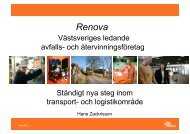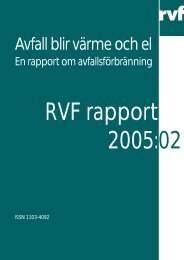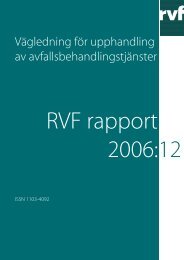SWEDISH WASTE MANAGEMENT |2010 - Avfall Sverige
SWEDISH WASTE MANAGEMENT |2010 - Avfall Sverige
SWEDISH WASTE MANAGEMENT |2010 - Avfall Sverige
You also want an ePaper? Increase the reach of your titles
YUMPU automatically turns print PDFs into web optimized ePapers that Google loves.
<strong>SWEDISH</strong> <strong>WASTE</strong> <strong>MANAGEMENT</strong> 2010<br />
considerably less common. Mixed combustible<br />
waste from single-family houses is in most<br />
cases collected in 190 liter wheelie bins and<br />
emptied every other week. Other than this,<br />
there are a number of different bag and bin<br />
sizes which are collected and emptied in various<br />
intervals. Waste from apartment blocks<br />
are normally collected weekly.<br />
Traditional back-loading vehicles are still<br />
the most common when it comes to waste collection,<br />
but the technology for multi-compartmented<br />
vehicles is developing and becoming<br />
more and more popular, while side-loading<br />
vehicles account for a more constant share of<br />
the operators’ vehicle fleet. An increasing<br />
number of vehicles use biogas as fuel, which<br />
the local authorities may control through purchasing<br />
requirements.<br />
Waste collection previously led to many<br />
work-related injuries. Daily heavy lifting was<br />
part of the job in the past, and waste collection<br />
required workers to be in good physical<br />
condition. Only a few waste collectors were<br />
able to work until the average retirement age.<br />
Today the situation is different. Bags have<br />
been replaced with bins or other types of containers.<br />
Manual handling of waste is being<br />
replaced with new technology and automated<br />
systems, such as refuse vacuum pipes and<br />
underground container systems. Both of these<br />
systems are on the increase, particularly in<br />
bigger cities. One of several advantages is that<br />
they do not require heavy manual handling.<br />
From the point of view of health and safety at<br />
work, vacuum collection systems are good<br />
since they are sealed and completely automated.<br />
This type of collection system reduces<br />
the need for waste transportation, especially<br />
in residential areas.<br />
There are two kinds of vacuum collection<br />
systems, a stationary system and a mobile<br />
system. With the stationary system the waste<br />
is collected using air in an automated vacuum<br />
system. It is thereafter transported through<br />
underground tubes, which connect the inlets<br />
with big containers placed in a terminal. With<br />
this technique the waste can be transported<br />
up to a distance of two kilometres from the<br />
inlets. The number of containers varies and<br />
depends on the one hand upon the number of<br />
collected fractions, and on the other hand on<br />
the waste volumes. The containers are collected<br />
by hook-lift vehicles.<br />
The mobile vacuum collection system also<br />
uses air to collect the waste. However, here<br />
the vacuum technique originates from the<br />
vehicle. Positioned under each input is a storage<br />
tank. The tanks are connected, via an<br />
underground pipe system, to a so called docking<br />
point which can be placed at a maximum<br />
distance of 300 meters from the tanks. The<br />
vehicle connects to the docking point for emptying,<br />
the vacuum system is turned on and air<br />
transports the waste from the different storage<br />
tanks to the docking point and onto the<br />
vehicle. Mobile vacuum collection systems<br />
require specialized vehicles.<br />
Another collection system that is on the rise<br />
is the underground container system. By placing<br />
containers underground, the need for<br />
space on the street level is reduced. The temperature<br />
below the street level, where the<br />
waste is contained, is relatively low, which<br />
prevents odor, and the containers are easily<br />
emptied with a crane truck. There are also<br />
underground containers that are emptied with<br />
front-loading vehicles. Since the underground<br />
containers can hold bigger volumes, the level<br />
of transports is reduced.<br />
7

















